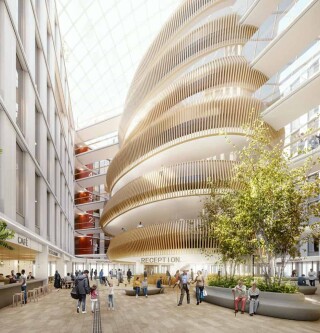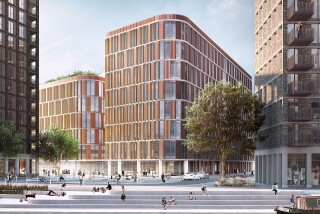Camden Council made a resolution to grant planning permission on 30th June for Oriel, a joint initiative between Moorfields Eye Hospital NHS Foundation Trust, UCL Institute of Ophthalmology (IoO)and Moorfields Eye Charity.
The ambition is to construct a centre for eye health that brings together clinicians, researchers and educators. Subject to approval by the Greater London Authority and conditions being met, Moorfields and the IoO will be able to relocate from their current buildings on City Road, Islington, to the St Pancras Hospital site in Camden.
The Oriel plans have been in the works since 2013. They were submitted to Camden Council for approval last November.
As of April 2020, construction costs were estimated at £179m and overall capital costs at £352m.
The building has been designed by lead architect Penoyre & Prasad (a studio of Perkins&Will London) along with Aecom providing expertise on engineering and sustainability and White Artkitekter on interiors and landscaping.
Under a separate contract, Aecom is providing project management services for Moorfields Eye Hospital and the UCL IoO to deliver the scheme.
Oriel is part of a wider masterplan for the five-acre St Pancras Hospital site with plans being brought forward separately by King’s Cross Central Limited Partnership (KCCLP) for mixed-use development on the remaining three acres of land.

David Probert, chief executive of Moorfields Eye Hospital NHS Foundation Trust said: “This is truly a significant milestone for Oriel and the future of patient-centred eye care. The new eye health centre will be a world first and has been designed to accommodate the greatest integration between research and patient care.”
Penoyre & Prasad’s design features a central atrium with two wings containing all the departments that make up Oriel. Rising up through the centre of the atrium is a tower-like structure containing the main public circulation and access to the different departments.
It is designed as an ‘adaptive building’ to accommodate a different activities that may change over time.
Aecom director of innovation Dale Sinclair said: “With its environmental credentials, including the ability of the building to adapt in the future in response to its circular economy approach, Oriel has the potential to set a precedent that will help guide the development of many future buildings in London and beyond. The team has worked collaboratively to reach this important milestone, developing low carbon solutions for this state-of-the-art facility.”
Penoyre & Prasad architect Rafael Marks said: “This building is a radical way of combining treatment, research, education seamlessly under one roof and offers and adaptable blueprint of how we could be designing sustainable environments of healthcare and life sciences.”
Got a story? Email news@theconstructionindex.co.uk





